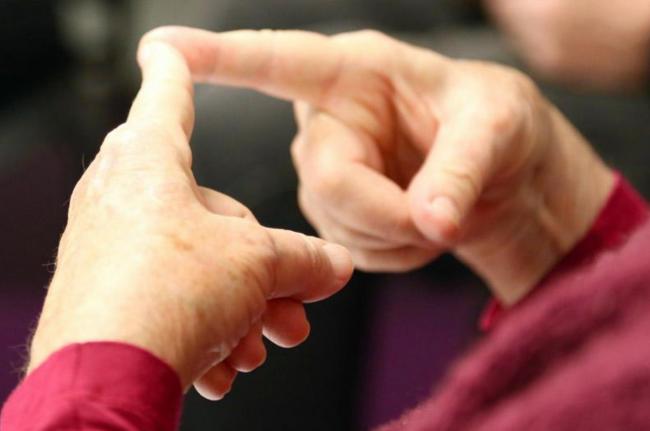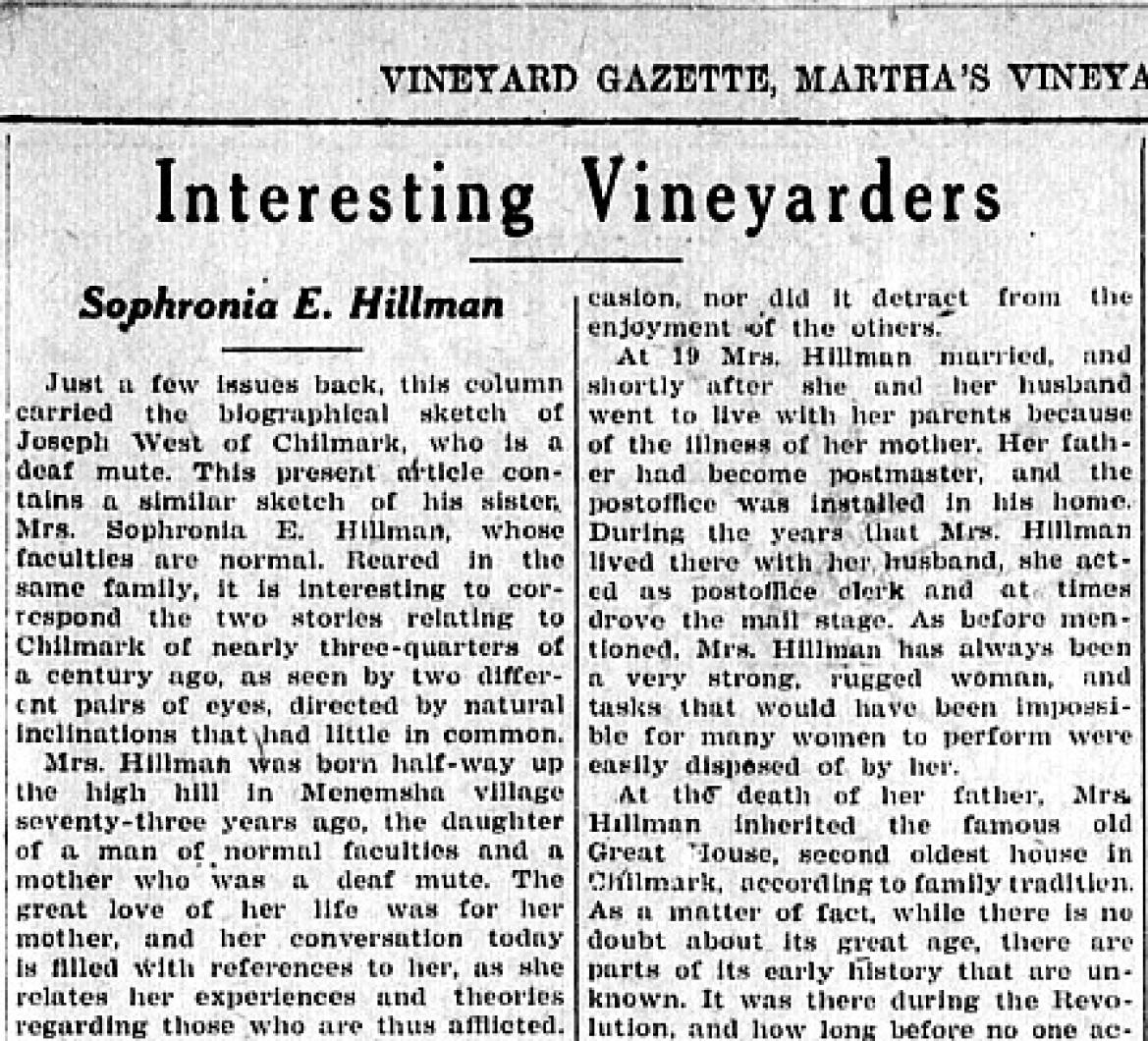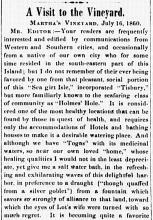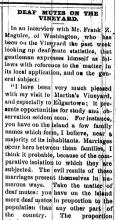Just a few issues back, this column carried the biographical sketch of Joseph West of Chilmark, who is a deaf mute. This present article contains a similar sketch of his sister, Mrs. Sophronia E. Hillman, whose faculties are normal. Reared in the same family, it is interesting to correspond the two stories relating to Chilmark of nearly three-quarters of a century ago, as seen by two different pairs of eyes, directed by natural inclinations that had little in common.
Mrs. Hillman was born half-way up the high hill in Menemsha village seventy-three years ago, the daughter of a man of normal faculties and a mother who was a deaf mute. The great love of her life was for her mother, and her conversation today is filled with references to her, as she relates her experiences and theories regarding those who are thus afflicted.
“There were nearly fifty deaf mutes in Chilmark when I was a child,” she says, “and it was noticeable that where a man and wife were both deaf mutes, their children were always normal. But when only one of a couple was deprived of speech and hearing some of the children could hear and speak while others could not.”
This was the case in her own family, but the picture she draws of her home life, as a child, indicates a home that was filled with happiness.
As a child Mrs. Hillman developed a great fondness for the outdoors, particularly brooks and streams of water. They had a fascination for her that has never diminished with the passing of time. Because she had ample opportunity to travel about, often accompanied by one of her smaller brothers, it was one of her favorite pastimes to follow brooks, seeking their sources, the branches that entered them and their outlets. Such a pastime might seem a peculiar one for a small girl, but Mrs. Hillman was always very robust and strong. Besides, walking was the principal mode of travel and a walk of a few miles was not considered as being anything to talk about.
Walked 7 Miles to Store
Her school was not far distant, but there were neighbors and friends to visit, and stores where she was sent on errands and none of them were very near. The single store in Chilmark was devoted principally to the handling of groceries, and she often walked seven miles down the North Road to another store that carried other wares. Her father and uncle were employed at the old brickyard on Roaring Brook, and she commonly walked down to the yard, a mere matter of five miles, to watch them at work or to visit at the grist mill.
Being thus well-trained in walking, she was amply qualified to explore and to trace the windings of the brooks which fascinated her childish mind. There is not a stream in Chilmark that she has not followed from source to outlet, and today, after the passage of more than sixty years, she can name each brook, and describe its wanderings over the various estates of the town. Property has changed hands many times since she walked the fields, and she uses the names of older owners, but she can describe the various locations in such detail that failure to recognize them is impossible.
With the passing of childhood she became interested in the social activities of the day, and her stories of these things sound very quaint compared with present day customs.
“It was very common for fifty or sixty young people to gather and attend prayer meeting at the school-house,” she says, “and after the meeting was over they would all go to some house for a party.”
Mrs. Hillman’s home was a popular gathering place for these young people. “Plum porridge,” parties and card games were favorite pastimes, in which the many young deaf mutes joined with enthusiasm. Their affliction was no handicap at any such occasion, nor did it detract from the enjoyment of others.
At 19 Mrs. Hillman married, and shortly after she and her husband went to love with her parents because of the illness of her mother. Her father had become postmaster, and the postoffice was installed in his home. During the years that Mrs. Hillman lived there with her husband, she acted as postoffice clerk and at times drove the mail stage. As before mentioned, Mrs. Hillman has always been a very strong, rugged woman, and tasks that would have been impossible for many women to perform were easily disposed of by her.
At the death of her father, Mrs. Hillman inherited the famous old Great House, second oldest house in Chilmark, according to family tradition. As a matter of fact, while there is no doubt about its great age, there are parts of its early history that are unknown. It was there during the Revolution, and how long before no one actually knows. This house became her home, and during the years that followed, the opportunity came to utilize its many rooms as a boarding house. It was in this historic structure that the builders of the famous Sanford mansion lived while that residence was being constructed. Artists and artisans, brought from great distances to design and fashion the various portion of the Menemsha show place, they brought with them tales of the outer world that were received with interest, and gossip from the construction job that was no less eagerly received. Road builders and fish buyers came and went, all making their headquarters at the Great House. And then Menemsha settled down to its former calm, commonplace existence once more.
Heart Is Still in Chilmark
The illness of her husband, and his subsequent death, caused Mrs. Hillman to leave Chilmark and move to Vineyard Haven, where she now resides. But her heart is still in Chilmark, and her tales are chiefly of the days of her youth when all things in that town were so different from today.
Her superior strength and capabilities have always made her services invaluable in cases of sickness among her acquaintances, and she has cared for many patients, thereby gaining an intimate knowledge of family history and relationship. She has watched the growth and development of her home town from a strictly farming district to the summer colony of today. There was no village at Menemsha Creek in her childhood, only three or four widely separated farms lying around the shallow, sandy inlet that has become the anchorage basin for the fishing fleet. The surfaced roads have all been built within her memory, many houses have been built, and many, alas, have disappeared from the hills.
She has met and conversed with many famous people, among whom were Alexander Graham Bell, the inventor of the telephone, who once visited for several weeks at her father’s home while studying the deaf and deaf mutes. Mrs. Hillman is very frank in her denunciation of Mr. Bell, condemning his theories regarding deaf mutes, and offering evidence that the celebrated gentleman jumped at conclusions.
“His claim that intermarriage was the cause is all wrong,” she says, “for there was nothing of the kind in my family as far back as it can be traced.”
And she says his prediction that intermarriage between deaf mutes would produce a race of deaf mutes has also been disproved, for “never in the history of Chilmark has a deaf couple become the parents of a deaf child.”
Still vigorous for her years, Mrs. Hillman lives alone, attending to her own wants, and doing considerable work for others. She cannot walk as far or as easily as she once did. Illness has sapped the vigor of former years. But she still remains spirited and determined, uncomplaining and self-reliant, and willing at all times to draw upon her retentive memory for tales of the long ago with which to entertain her friends. “Different” stories than are told by most people of her age, but highly interesting and revealing a little-known angle of Vineyard history.











Comments